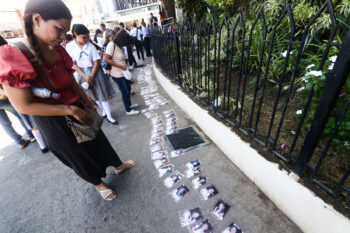GENERAL SANTOS CITY (MindaNews / 19 March) – Through enterprising reporters and their various sources, media exposed the American participation in “Oplan Exodus” and four other “Oplans”, dating back to 2010, for the capture of Malaysian international terrorist Julkipli bin Hir alias “Marwan”, and his Moro associate Abdulbasit Usman. The media reports and a brief summary from the PNP Board of Inquiry Report were the subjects of our March 17 MindaNews article, “MindaNews: American Equation in BOI Report”.
The PNP BOI Report summary of its investigation of “Oplan Exodus”, better known as the “Mamasapano massacre”, was released on line last March 13. The brief summary referring to the American participation, “Conclusion 21”, only stated: “The United States involvement was limited to intelligence sharing and medical evacuation. Only SAF Commandos were involved in the actual combat operation of Oplan Exodus.” This, however, has a validating implication on the media reports.
The Senate made public on March 16 the report of its committee investigation of the Mamasapano incident. The executive summary released online last Tuesday, March 17, contained a longer account of the American participation. This complements the BOI Conclusion 21 and implicitly validates further the media reports.
The Senate Committee Report summary of the American participation, quoted in full:
[Author’s Note: Paragraph number and letter markings are ours for comment reference. – PPD]
[1] The testimonies of various resource persons, particularly during the executive hearings, provide indications that the US had significant participation in Oplan Exodus. (Bold italics ours)
[2] This is contrary to the submission of the Department of Foreign Affairs (DFA) that based on their discussions with the United States authorities, they were able to ascertain that the planning and the execution of the Oplan Exodus were 100% Filipino planned and implemented.
[3] The following facts, based on testimonies which the Committees had approved to be made public, were attested to:
- (a) Napeñas brought three Americans into the Army Brigade headquarters (HQ). A helicopter arrived and three more Americans came into the HQ and joined Napeñas at his work table.
- (b) One of the Americans, identified by Napeñas as Al Katz, supposedly handled the training of the Seaborne.
- (c) One of the Americans ordered Maj. Gen. Edmundo Pangilinan to fire the artillery. However, Pangilinan refused and told him, “Do not dictate to me what to do. I am the commander here!” (Bold italics ours)
- (d) The Americans provided surveillance in the area through their Intelligence Surveillance Reconnaissance (ISR). TV monitors were brought in by the Americans to the HQ.
[4] Briefly, ISR in the United States is shorthand for “…the system of collection assets and analysts which brings information about the enemy or potential enemy to the decision-maker, whether that decision-maker is a top general in Washington, DC or a soldier on the ground facing an armed attacker.”
[5] During the public hearings on the Mamasapano incident, Napeñas admitted that a “U.S. counterpart” was involved in at least three aspects – intelligence cooperation, training and equipment provision:
[6] MR. NAPEÑAS: “Your Honor, tumulong iyong US counterpart doon sa intelligence… Mayroon kaming isang US counterpart doon sa Seaborne who is working with them in terms of training at saka iyong…equipment provision, Your Honor. Kasama po iyon na ibinibigay nila iyong maps na ginagamit for operation. But never nakasama iyong US counterpart in actual combat.”
[7] Although the DFA emphasized that “the only constitutionally restricted activity in Philippine cooperation with the US under existing agreements is that, they (US) may not and have not, in the case of Mamasapano either, engage in combat operations” and which nonparticipation in combat was affirmed by PDIR Napeñas, the Committees recommend that the executive branch, in particular the DFA and the VFA Commission, consider taking steps to clarify and address issues regarding US role and involvement in domestic counter-terrorism and internal security that surfaced in our legislative inquiry into the Mamasapano incident.
It should be noted:
First, the Senate Report (SR) underscores the difference between its findings and of the submission of the Department of Foreign Affairs, [1], [2] and [7], and, without direct reference, from the PNP BOI Conclusion 21. In media reports, the DFA Secretary’s statements were the “DFA submission”.
Second, Napeñas provided much of the information, [3], [5] and [6].
Third, the Americans brought sophisticated surveillance equipment, the ISR, [4] and [3](d).
Fourth, six Americans were with Napeñas at the SAF TCP (technical command post) at the Army Brigade Headquarters in Shariff Aguak, Maguindanao, [3](a). Note that three were brought by Napeñas and three came later by helicopter. The same number the media and PNP sources – although other reports mentioned “eight”.
Fifth, one of the Americans, “Al Katz”, supposedly trainer of the Seaborne (84th SAF Company), [3](b), was named in the media reports as “Allan Konz” and identified as the “supervisor and in fact the commander” of the 84th SAF.
Sixth, that one of the Americans had the temerity to order the 6th ID commander to fire the artillery, [3](c), suggested they did not just silently monitor the operations but they, indeed, gave orders – the backseat drivers behind Napeñas.
Seventh, the DFA submission implies that “funding, direct training, equipment provision and monitoring of the actual operation without taking part in the combat” are not within “constitutional restrictions under existing agreements”[7].
The full reports of the PNP BOI and the Senate Committees must have “more spicy” details. The DFA submission to the Senate attesting that the “planning and execution were 100% Filipino” – excepting the aspects not restricted constitutionally and those allowed by bi-lateral agreements – only whetted the negative.
In our March 17 “Mind da News” piece, we posed referring to the evident American involvement: Does this explain why, as the President said in his 30-minute narrative after the March 9 prayer meeting, Napeñas did not abort the January 25 operation when he should have; why he panicked and made erratic decisions? Does this explain why Napeñas did not coordinate through the chain of command with the military and the MILF despite his “Yes, Sirs” to the President?
Positively, the American-pertinent portion of the executive summary of the Senate report clarifies further the questions posed: Napeñas was left alone with – and worse, TO – the Americans.
The “significant” involvement of the Americans is beyond doubt.
Ultimately, should the American involvement be condemned?
The media and the PNP BOI and Senate investigation reports were factual. They left it to the readers and the Filipinos to draw their own conclusions. Such conclusions vary.
To most, there’s nothing wrong with the American involvement. When the Philippines is in trouble, often, American assistance or support is asked and most welcomed.
To the nationalists, Philippine sovereignty is paramount. But Filipino national leaders in the Executive and in the Congress, while jealous of Philippine sovereignty, willingly compromise it in the name of military assistance and economic development. So, the Americans were driven out of the Clark and Subic Bay military bases but were invited back through the VFA (Visiting Forces Agreement) and other related executive agreements.
To the leftists, it’s “Go home, Yankees!” But they pose no objection to “Send dollars!” in times of calamities.
To the cynics, if Marwan was that real as a threat to the U.S. and international security, why did Uncle Sam not send the Navy Seals or other commando units to get Marwan and his associate? Why must Filipino lives be sacrificed to the fulfillment of the U.S. role as international policeman?
[AUTHOR’S NOTE: Mind da News, the alternate of COMMENT, is a comment on current news. The author may be contacted at patponcediaz@yahoo.com.]







